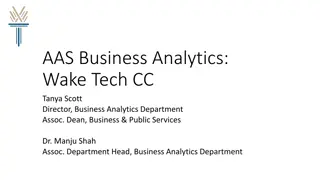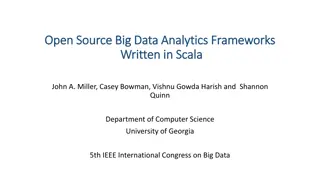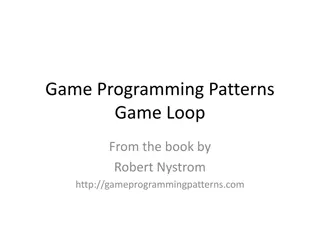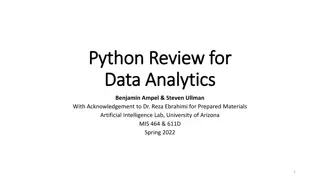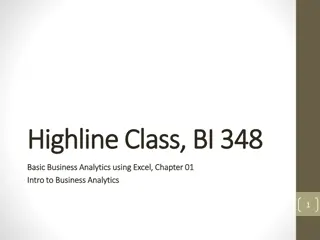Understanding Game Analytics: Types, Steps, and Concepts
Explore the world of game analytics by learning about the two main types of data - quantitative and qualitative, the steps involved in the analytics pipeline, the difference between population and sample, probability sampling, and the concept of variables in statistics.
Download Presentation

Please find below an Image/Link to download the presentation.
The content on the website is provided AS IS for your information and personal use only. It may not be sold, licensed, or shared on other websites without obtaining consent from the author. Download presentation by click this link. If you encounter any issues during the download, it is possible that the publisher has removed the file from their server.
E N D
Presentation Transcript
Review Review IMGD 2905
What are two main What are two main types of for game analytics? for game analytics? types of data data
What are two main What are two main types of data for game analytics? for game analytics? types of data Quantitative instrumented game Qualitative subjective evaluation
What steps are in the What steps are in the game analytics pipeline game analytics pipeline? ?
What steps are in the What steps are in the game analytics pipeline game analytics pipeline? ? Game (instrumented) Data (collected from players playing game) Extracted data (e.g., from scripts) Analysis Statistics, Charts, Tests Dissemination Report Talk, Presentation
What is What is population population versus versus sample sample? ?
What is What is population population versus versus sample sample? ? Population all members of group pertaining to study Typically want parameter of this group Sample part of population selected for analysis Typically compute statistic to estimate parameter
What is What is probability sampling probability sampling? ?
What is What is probability sampling probability sampling? ? Probability sampling selecting members from the population group while considering the likelihood of selection Likelihood as part of population
What is a What is a Variable Variable in Statistics? in Statistics?
What is a What is a Variable Variable in Statistics? in Statistics? Any characteristics that can be measured, classified or counted e.g., age, eye color, income, high score, kill-death ratio, vehicle type e.g., time spent in competitive mode in Starcraft 2 e.g., vehicle choice in Grand Theft Auto (GTA) Variables in columns Independent variable is inherent in population, versus dependent variable that want to assess Player Hours Champ A 2 B 7.5 Leona Teemo
What is a What is a Pareto chart Pareto chart? ? When used? When used?
What is a What is a Pareto chart Pareto chart? ? When used? When used? Used for categorical data Bar chart, arranged most to least frequent Line showing cumulative percent Helps identify most common, relative amounts
When should you When should you not not use use pie chart pie chart? ?
When should you When should you not not use use pie chart pie chart? ?
When should you When should you not not use use pie chart pie chart? ? http://cdn.arstechnica.net/FeaturesByVersion.png When too many slices
When should you When should you not not use use pie chart pie chart? ? (Often) when comparing pies
Which Which Measure of Central Measure of Central Tendency Tendency to Use? Why? to Use? Why?
What are What are Quartiles Quartiles? ?
What are What are Quartiles Quartiles? ? 3 values that divide population into 4 equal sized groups
Describe how to Describe how to Compute Compute Variance Variance
Describe how to Describe how to Compute Compute Variance Variance 1. Compute mean 2. Take a sample and compute how far it is from mean. Square this 3. Repeat #2 for each sample 4. Add up all 5. Divide by number of samples (-1)
What is Mendenhalls What is Mendenhall s Empirical Rule? Empirical Rule?
What is Mendenhalls What is Mendenhall s Empirical Rule? Empirical Rule? https://mathbitsnotebook.com/Algebra1/StatisticsData/normalgrapha.jpg
What can you interpret What can you interpret from a Z from a Z- -score? score?
What can you interpret What can you interpret from a Z from a Z- -score? Where (above or below) score is relative to the median How unusual a score is score?
In Probability, what is an In Probability, what is an Exhaustive Set of Events? Give an Example. of Events? Give an Example. Exhaustive Set
In Probability, what is an In Probability, what is an Exhaustive Set of Events? Give an Example. of Events? Give an Example. Exhaustive Set A set of all possible outcomes of an experiment or observation e.g., coin: events {heads, tails} e.g., d6: events {even number, odd number} e.g., picking Champion in LoL: events {Shen, Teemo, Leona, } (all possible Champions listed)
What What Numeric Values Numeric Values do Probabilities take? Probabilities take? do
What What Numeric Values Numeric Values do Probabilities take? Probabilities take? do Probabilities must be between 0 and 1 (but often written/said as percent) Probabilities of set of exhaustive, mutually exclusive events must add up to 1
Probability Probability Poll 1! Draw 1 card. What is the probability drawing a Jack?
Probability Probability Poll 1! Draw 1 card. What is the probability drawing a Jack? P(J) = 2 favorable outcomes / 5 total outcomes = 2/5
Probability Probability Poll 2! Draw 2 cards simultaneously. What is the probability of drawing 2 Jacks?
Probability Probability Poll 2! Draw 2 cards simultaneously. What is the probability of drawing 2 Jacks? P(2J) = P(J) x P(J | J) = 2/5 x 1/4 = 1/10
Probability Probability Poll 3! Draw 3 cards simultaneously. What is the probability of not drawing at least one King?
Probability Probability Poll 3! Draw 3 cards simultaneously. What is the probability of not drawing at least one King? P(K ) x P(K | K ) x P(K | K K ) = 3/5 x 2/4 x 1/3 = 6/60 = 1/10
Characteristics of an Characteristics of an experiment with a experiment with a Binomial Distribution Distribution of outcomes? of outcomes? Binomial
Characteristics of an Characteristics of an experiment with a experiment with a Binomial Distribution Distribution of outcomes? of outcomes? Experiment consists of n independent, identical trials Each trial results in only success or failure (probability p for success for each) Random variable of interest (X) is number of successes in n trials Binomial
Characteristics of an Characteristics of an experiment with a experiment with a Poisson Distribution Distribution of outcomes? of outcomes? Poisson
Characteristics of an Characteristics of an experiment with a experiment with a Poisson Distribution Distribution of outcomes? of outcomes? 1. Interval (e.g., time) with units 2. Probability of event same for all interval units 3. Number of events in one unit independent of others 4. Events occur singly (not simultaneously) 5. Random variable of interest (X) is number of events that occur in an interval Poisson Phrase people use is random arrivals
Expected Value Expected Value What is average if don t bust? Toss: Flip 2 coins Each Head gives 1 point 2 Tails bust, turn over A = HT + TH + HH = (1 + 1 + 2) / 3 = 4/3 Poll! What is the expected value after 1 toss? E(X) = P(TT) * 0 + (1- P(TT)) * 4/3 = * 4/3 = 1 2 tosses? E(X) = (1-P(TT))2 * (4/3 * 2) = * * 8/3 = 1.5 3 tosses? E(X) = (1-P(TT))3 * (4/3 * 3) = * * * 12/3 BEST_BOT? = 1.6875
Expected Value Expected Value What is average if don t bust? Toss: Flip 2 coins Each Head gives 1 point 2 Tails bust, turn over A = HT + TH + HH = (1 + 1 + 2) / 3 = 4/3 What is the expected value after 1 toss? E(X) = P(TT) * 0 + (1- P(TT)) * 4/3 Poll! = * 4/3 = 1 2 tosses? E(X) = (1-P(TT))2 * (4/3 * 2) = * * 8/3 = 1.5 3 tosses? E(X) = (1-P(TT))3 * (4/3 * 3) = * * * 12/3 BEST_BOT? = 1.6875
Expected Value Expected Value What is average if don t bust? Toss: Flip 2 coins Each Head gives 1 point 2 Tails bust, turn over A = HT + TH + HH = (1 + 1 + 2) / 3 = 4/3 What is the expected value after 1 toss? E(X) = P(TT) * 0 + (1- P(TT)) * 4/3 = * 4/3 = 1 2 tosses? E(X) = (1-P(TT))2 * (4/3 * 2) Poll! = * * 8/3 = 1.5 3 tosses? E(X) = (1-P(TT))3 * (4/3 * 3) = * * * 12/3 BEST_BOT? = 1.6875
Expected Value Expected Value What is average if don t bust? Toss: Flip 2 coins Each Head gives 1 point 2 Tails bust, turn over A = HT + TH + HH = (1 + 1 + 2) / 3 = 4/3 What is the expected value after 1 toss? E(X) = P(TT) * 0 + (1- P(TT)) * 4/3 = * 4/3 = 1 2 tosses? E(X) = (1-P(TT))2 * (4/3 * 2) = * * 8/3 = 1.5 3 tosses? E(X) = (1-P(TT))3 * (4/3 * 3) = * * * 12/3 BEST_BOT? = 1.6875
Expected Value Expected Value What is average if don t bust? Toss: Flip 2 coins Each Head gives 1 point 2 Tails bust, turn over A = HT + TH + HH = (1 + 1 + 2) / 3 = 4/3 What is the expected value after 1 toss? E(X) = P(TT) * 0 + (1- P(TT)) * 4/3 = * 4/3 = 1 2 tosses? E(X) = (1-P(TT))2 * (4/3 * 2) = * * 8/3 = 1.5 3 tosses? E(X) = (1-P(TT))3 * (4/3 * 3) = * * * 12/3 BEST_BOT? = 1.6875
Expected Value Expected Value What is average if don t bust? Toss: Flip 2 coins Each Head gives 1 point 2 Tails bust, turn over A = HT + TH + HH = (1 + 1 + 2) / 3 = 4/3 What is the expected value after 1 toss? E(X) = P(TT) * 0 + (1- P(TT)) * 4/3 = * 4/3 = 1 2 tosses? E(X) = (1-P(TT))2 * (4/3 * 2) = * * 8/3 = 1.5 3 tosses? E(X) = (1-P(TT))3 * (4/3 * 3) = * * * 12/3 BEST_BOT? = 1.6875
What is the What is the Standard Normal Distribution Normal Distribution? ? Standard
What is the What is the Standard Normal Distribution Normal Distribution? ? Standard Normal distribution Mean = 0 Std dev = 1 = 0
What is the What is the Central Limit Theorem Central Limit Theorem? ?
What is the What is the Central Limit Theorem Central Limit Theorem? ? Given population If take large enough sample size What does probability of sample means look like? Distribution shape?


